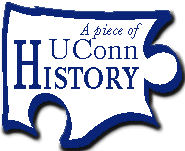This is an archived article. For the latest news, go to the Advance Homepage. For more archives, go to the Advance Archive/Search Page  | ||
|
Koons lives on in campus landmarks
>First in a new series examining the history and traditions of our University of Connecticut.Benjamin Franklin Koons was educated at Oberlin College, an early bastion of co-education. It's not surprising then that it was during Koons' tenure as president that women were first admitted to the agricultural school that would become the University of Connecticut. His name is on one of the oldest brick buildings on campus and there is a plaque in his memory on a massive rock that we pass each day on North Eagleville Road. But who was Benjamin F. Koons?
A Civil War veteran who was born in Sulphur Springs, Ohio, in 1844, he was hired in 1881 to teach natural history as one of three faculty members of the new Storrs Agricultural School. In 1883 he became principal of the school, in addition to his teaching duties, and he also was authorized as "the exclusive purchasing agent for all things at the institution." Koons became president in 1893, when the school became the Storrs Agricultural College under the same legislative act that allowed the admission of women. But Koons three years earlier had been approached by "several young ladies in the vicinity" who asked to be admitted. He allowed them to take classes starting in 1891, later citing the spirit - if not the letter - of the law for his decision. Three women graduated from the college in 1894 - and the centennial of their admission was celebrated by UConn in 1991. As a faculty member, Koons taught a variety of science courses and published research papers on geology, entomology, zoology and mineralogy. Throughout his tenure he "devoted considerable energy and attention to acquiring, preserving, and exhibiting specimens in the Museum of Natural History which grew to a substantial collection," wrote James Barnett in a brief biography of Koons in 1981. The museum was in the Old Main Building, an 1890 wooden structure that was demolished in 1929; the collections started by Koons were moved to the then new Beach Hall, other buildings or put into storage. No written record exists that explains why Koons resigned as president in 1898. Historical accounts report that trustees were dissatisfied with the degree of freedom he had allowed for the faculty and wanted a stronger leader. He returned to the faculty as a professor of natural history and political economy and was appointed curator of the Museum of Natural History. Koons died of throat cancer on December 17, 1903. Alumni of what was then known as Connecticut Agricultural College bore his coffin from the Storrs Congregational Church to the Storrs Cemetery. Mark Roy Sources: "Three Storrs Pioneers" by James H. Barnett, emeritus professor of sociology, 1981; and "Connecticut Agricultural College - A History," by Walter Stemmons, 1931. |


